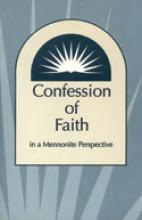Update: In October 2020, Mennonite Church Eastern Canada announced the termination of the ministerial credentials of John D. Rempel, on the basis of ministerial sexual misconduct. To learn more, see ‘Credentials terminated for theologian-academic-pastor.’
The heart of the Christian life is aligning ourselves with God’s love. We squander love and then turn to the Spirit to fill us with it again. Even harder than that, especially as we try to make sense of our church’s current struggles, is what to do when we come to the sinking feeling that our problem might be that we understand God’s love in different and contrary ways.
“Conservatives” in our church wake up at night worrying that the boundaries set up to keep us faithful might not hold. “Liberals” wake up at night worrying that the boundaries might replace the centre as the basis of faithfulness.
We are slowly and painfully realizing that two different ways of looking at the church and the world have arisen among us. On the one hand, we struggle to pinpoint the source of our disagreements; on the other, we fear naming what most deeply divides us because the breach might be too big to bridge.
Such a fundamental difference of worldviews is the only adequate explanation I can find for the visceral character of the debate that has accompanied changing positions on defining practices of the church: divorce, women in leadership and homosexuality. In mainstream Mennonitism in North America today, homosexuality is the most emotionally laden stand-in issue for a profound set of differences in belief and practice. I commend Mennonite Church Canada for the courage and wisdom it has shown in devising a process—Being a Faithful Church—to unpack five hard questions facing the church and that it has not shrunk from addressing the most volatile of these: homosexuality.
Homosexuality is the scapegoat for much of our confusion, fear and anger about the shaking foundations of our faith. Whether or not the gospel blesses the love of gay people is a vexing issue, but it is only one expression of a wider and deeper contest between conflicting sets of assumptions by which we live. No one issue can bear the weight of all our confusion, fear and anger. Only if we find ways of identifying the underlying assumptions of our strife, can we hope for reconciliation.
Here is one attempt to name what is at stake. Let’s look at four realities that shape how we see the world.
The tension between the authority of the Bible and the Holy Spirit
The Bible is a written record of God’s revelation and our response. The Old Testament describes events like the Hebrew exodus from Egypt and the giving of the Ten Commandments. The New Testament describes events like the coming of Christ and the community that arose in response to him.
We want to live out what Scripture teaches, but doing so always involves applying an old story to a new setting. This is where the Holy Spirit comes in. For example, we read in the gospels that Christ came to redeem Israel. In Acts we read that Christ’s redemption also includes the gentiles. Through the Spirit’s prodding the apostolic church realized that there was room in Israel’s covenant with God for the gentiles. In his farewell discourses in John 14:11-29, Jesus promises his disciples “another advocate,” a presence of God who will teach them how to live a life of love after he has gone.
This means that the Bible can be the final authority for the church only when it is illuminated by the Spirit. But who is to say where the Spirit is leading?
Confessions of faith have been exercises and models of discernment for Mennonites in applying the Bible to the hard questions of the day. When the church accepts the articles of a confession of faith, it is saying that they come as close as possible to describing Christ’s way.
Because we always “know in part,” grappling with our beliefs and practices continues. This grappling has led groups across the spectrum to question and reject parts of the confession:
As regards the status of women and men (Article 6), the Confession of Faith in a Mennonite Perspective asserts that the rule of man over woman is the result of sin and that in redemption they are both restored to the image of God. The Confession concludes that God calls leaders from both genders. Some conservatives reject this position.
- On the practice of communion (Article 12), the Confession states that only those who are baptized are invited to the Lord’s Table. Some conservatives and some liberals reject this position.
- On the question of sexual union (Article 19), the Confession asserts that it belongs only within heterosexual marriage. Some liberals reject this position.
Yet the only issue on which conformity to the Confession is called for by our denomination has to do with the implied rejection of same-sex marriage (Article 19). One of the few departures from the Confession that is disciplined is when a minister presides at a same-gender union. Nothing is done, for example, when members or ministers publicly reject a Trinitarian understanding of God (Article 1), or when members or ministers publicly reject the peace teaching (Article 8 and 22).
What is happening here? Individuals and groups are at odds about the Confession’s discernment of where Scripture interpreted by the Spirit leads. To be sure, no single process of discernment in a single period of time is absolute. But without the Confession as a referee, as a document in its own right and as a symbol of the tradition, there is no agreed-upon way of measuring faithfulness. Yet sincere people disagree about which issues in the Confession adequately express the leading of the Spirit today and which issues are of a church-dividing nature.
The dominant historical position has been that confessions identify those things that unite us and that must unite us to remain faithful. Our present Confession stands in that tradition. It offers a permeable orthodoxy in which historic positions are affirmed, but with respect for a range of interpretation.
For instance, the Confession asserts that Christ died to save us (Article 8), adding that each of the classic ways of making sense of Jesus’ death—Christus victor, substitutionary atonement, moral influence—shed the Spirit’s light on biblical teaching. Our Confession seeks to set forth the essentials of the gospel as Mennonites have understood it, while making room for diversity of interpretation that remains accountable to the core.
What do we do when a significant part of the church finds the discernment set forth in the Confession inadequate to the needs of the day and the leading of the Spirit for the day? Do we resort to congregational autonomy? If so, are there no positions on which we must be of a common mind to faithfully live out the will of God?
Another approach is to say that it is relationships of trust, respect and patience that are called for to hold our denomination together. These virtues are indispensible. But can the full weight of community be carried by relationships? Aren’t we accountable to truths of the sort that are interpreted in the Confession, which we accept at baptism?
More is at stake than the issue itself
We are reluctant to admit that it is not only a particular issue on which we disagree; we fear that the assumptions underlying it might be at stake. Most of us have a haunting gut feeling that more is at stake than the issue itself when we see the passion our disagreements provoke, but we can’t put that gut feeling into words.
Take the explosive issue of abortion. Conservatives oppose it with a passion. Part of what drives them is that they’re against the taking of human life. But a pro-life position is equally a symbol of a deeper moral imperative: it is a line in the sand drawn in defence of “traditional values” as defined by right-wing Conservative ideology.
Liberals defend abortion—sometimes on-demand—because they want a way for women to get out of desperate circumstances. But they also defend abortion rights because it symbolizes a deeper moral imperative: it is a line drawn in the sand in defence of “individual rights” as defined by left-wing Liberal and New Democratic ideology.
We fear that if we identify the depth of our differences—within families, congregations and church agencies—they would become truly unmanageable.
Sometimes these debates are perpetuated by ongoing reactions by one side of the issue against the other. To illustrate, people on the left decry the abandonment of the peace position by some people on the right. On the surface, the leftists have the authority of the historical Mennonite interpretation of Jesus’ teaching on their side.
But some people on the right are also reacting to a pacifist position in which belief is often reduced to ethics. The nonviolence of some Mennonites grows out of scepticism about revealed truth; all that remains for them of religion is its morality.
Because the need for peacemaking initiatives is so urgent, arguments for peace and justice that are not theologically grounded have been shielded from criticism in our denominational culture. This unwillingness by centrists and leftists to make theological judgments in this realm only fuels the conservative fear that it is ultimately not the peace teaching—but belief in God’s self-revelation—that is at stake.
Privileging different parts of the Bible
The third reality grows out of one of the riches of our tradition. Mainstream Mennonites of different theological vantage points have done probing and respectful work on the Bible, both on scholarly and popular levels. Most of us would agree that the preaching of the Old Testament prophets brings us closer to the reign of God than the detailed prescriptions of the law found in Leviticus.
But each school of thought goes on to privilege parts of the Bible in more contentious ways. As regards the New Testament, some claim that the heart of the gospel is found in the ethics of Matthew, Mark and Luke, while others assert that it is found in the spirituality of the writings of Paul and John.
Every approach to the Bible makes use of a hierarchy of truths. Interpretations that see the ordering of society as one of God’s greatest gifts privilege passages like Romans 13:1-7 (“Let every person be subject . . .”). People who see the radical re-ordering of society as a greater gift privilege passages like Acts 17:1-8
(“. . . there is another king named Jesus.”).
We need clearer criteria for why we claim that some passages are more central to God’s purposes for the church and the creation than others. Otherwise, we will continue to talk past one another.
For example, a convinced conservative can reject the binding authority of Matthew 5:38-48 (“Do not resist an evildoer . . .), yet insist on the authoritativeness of Paul’s condemnation in Romans 1:18-32 (“. . . men were consumed with passion for one another”). A convinced liberal can do the opposite.
A starting point for honest discernment would be to admit that we hold different interpretations of the Bible, to lay out how we decide what is authoritative and how we live in response to it.
Mission: Changing individuals or structures?
Finally, there is the question of mission. It is of defining importance because it refuses to let us solve the problems before us simply with words. The mark of the follower of Jesus is “the obedience of faith” (Romans 16:26). Being a faithful believer and being the faithful body of Christ grows out of taking a chance on God, taking the risk of living as if the kingdom has come near (Mark 1:15). Everything else is “noisy gongs and clanging cymbals” (I Corinthians 13:1).
Risky living is the level playing field on which all contenders for rightly understanding the gospel meet. It does not mean, however, that truth claims are irrelevant. Let’s simplify the two contending visions of mission for the sake of discussion:
- Is our calling to witness to Christ as the saviour of the world and to build up a church of those who confess him as Lord?
- Or is our calling to make common cause with all who put themselves on the line for peace and justice?
Many Christians—and people who staff our church agencies—work hard to transcend that polarity. For a long time one of our predecessor mission boards had the motto: “The whole gospel for a broken world.” Nevertheless, in our agencies, schools and congregations, people tend towards one of the extremes.
On the one hand are believers who know the tyranny of sin in their own lives and have been set free from it by Christ. They know of no higher calling than witnessing to amazing grace. These people sometimes become so preoccupied with personal conversion that they forget it is only the entry point into God’s purpose for the creation.
On the other hand are believers who know the tyranny of sin in the life of ghettoes and nations, and are convinced that God’s reign can free the world from oppression and war. They sometimes become so preoccupied with systemic change that they forget that only individuals who have been made whole by Christ can stay the course in bringing wholeness to the world.
If people across the spectrum can acknowledge that what they are called to—changing structures or individuals—concerns only a part of the gospel, and that their ministry remains vital only if there are stewards of other parts of the gospel, both their ministries become complementary and mutually affirming.
These emphases become divisive and destructive when each side insists that only its way is faithful. Those who make personal conversion all there is to the gospel, and insist that work for justice is a distraction from the church’s mission, have only half a gospel. Similarly, those who see evangelism as an offence against other truth claims, and have no heart for seeing lost people find themselves in Christ, have only half a gospel. This is where the debate about mission needs to start.
When we risk speaking and praying truthfully and charitably about how we understand the Bible and the Spirit, when we risk unpacking our unspoken, underlying assumptions, when we risk facing the selectivity with which all of us approach the Bible, when we risk a deeper understanding of evangelism and justice in the coming of the kingdom, then we will have found our way back to the path that aligns us with God’s love.
John D. Rempel, Ph.D., takes over the role of director of the Toronto Mennonite Theological Centre at the Toronto School of Theology this fall, following his retirement from Associated Mennonite Biblical Seminary, Elkhart, Ind., at the end of the current academic year.
For discussion
1. John Rempel suggests that members in our churches have widely divergent worldviews. Do you agree? How would you describe the major polarities in Mennonite congregations? Do the terms “conservative” and “liberal” help or hinder us in describing our points of view?
2. How do our views of the world influence how we approach the Bible? How can we invite the Spirit of God to help us discern Scripture so that we don’t assume that “we” understand better than “them”? How worried should we be if there is a diversity of understanding of how to interpret Scripture? How much of the diversity is due to cultural norms as described in Troy Watson’s column on page 13?
3. Rempel says that, “every approach to the Bible makes use of a hierarchy of truths.” What do you think he means by this? Why is it so difficult to articulate our underlying assumptions? What could we do to be more honest in our discerning of Scripture?
4. Do you agree that our congregations struggle between the polarity of those who believe the important message of the gospel is personal conversion and those who believe it is the work for justice? What are the core beliefs on which we all can agree?





Add new comment
Canadian Mennonite invites comments and encourages constructive discussion about our content. Actual full names (first and last) are required. Comments are moderated and may be edited. They will not appear online until approved and will be posted during business hours. Some comments may be reproduced in print.